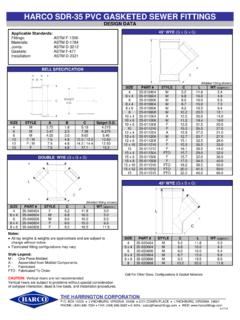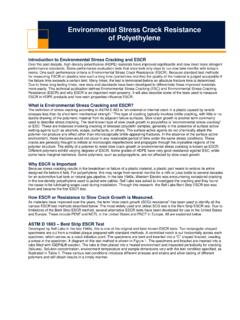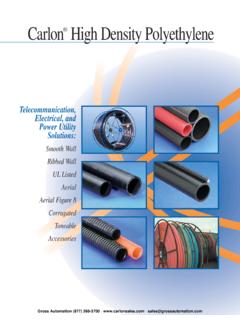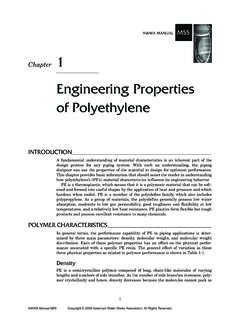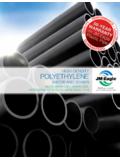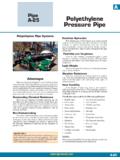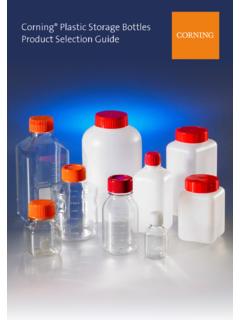Transcription of Generally speaking there are 3 different densities used to ...
1 Generally speaking there are 3 different densities used to manufacture polyethylene pipe. high density polyethylene is commonly referred to as HDPE or 3408. The molecular structure of HDPE is such that there is very little side branching in the molecular chains that make up the HDPE resin. This resin is more dense than other resins, therefore it requires relatively less raw material to obtain a specific pressure rating for the pipe. Medium density polyethylene is commonly referred to as MDPE or 2406. The molecular structure of 2406 material has more side branching in the molecular chains, therefore they do not stack on top of each other as well as HDPE.
2 Molecular chains do. It requires more material to get the same pressure rating as the same pipe manufactured with HDPE. However, because the MDPE. material is less dense, it is more flexible than HDPE. Linear Low density polyethylene is commonly referred to as LLDPE. The side branching of the molecules that make up LLDPE is significant. Pipe manufactured from this type of resin is primarily used for no pressure rated applications, such as drip or microirrigation. HDPE molecular chains stack on top of each other very neatly, much like 2 x 4. wood would stack: MDPE molecular chains do not stack as neatly as HDPE chains do and stack like twigs from a tree.
3 LLDPE molecular chains do not stack on top of each other neatly at all. So, as the density of polyethylene resin increases, the flexibility of the pipe decreases. But, as the density of polyethylene increase, less raw material is required to get identical pressure ratings. polyethylene pipe is Generally manufactured in the United States using 3. different dimensions. Iron Pipe size pipe has the identical dimensions as iron pipe does. This pipe is commonly referred to as IPS or SDR pipe. The outside diameter of IPS pipe is the controlling dimension. In other words, all 4" IPS polyethylene pipe will have a " outside diameter (OD).
4 The pressure carrying capabilities of this pipe then, is directly related to the wall thickness of the pipe. As the wall thickness increases, the inside diameter decreases, because the OD remains constant. The thicker the wall, the higher the pressure rating of the pipe. IPS polyethylene pipe can also be called SDR pipe. SDR stands for Standard Dimension Ratio. The ratio referred to is the ratio between the Outside Diameter (OD) and the wall thickness. The resulting number is often used to determine the pressure capacity of the pipe. For example: As stated 4" IPS polyethylene pipe has " OD. The wall thickness of 160. Pound (PSI) pipe is roughly.
5 409". If you divide by .409 the resulting number is Therefore this pipe may be referred to as SDR 11. If the wall changes, the resulting number from the ratio will also change. For example: 4" IPS 100 Pound (PSI) pipe has a wall thickness of .265". The OD remains constant and therefore the ratio is " to roughly .265" and the resulting number is obtained from the ration is 100 Pound pipe may then be referred to as SDR 17. Copper Tube size polyethylene pipe is sized like copper pipe and is also manufactured with the Outside Diameter (OD) as the controlling dimension. Copper Tube size or CTS pipe is commonly referred to as tubing.
6 In virtually all CTS applications the pressure rating of the pipe will be 200 PSI. Because the OD is the controlling dimension, this pipe may also be called SDR pipe, but is different than IPS pipe. Since the applications using CTS pipe virtually always require 200 PSI pipe the resulting number from the ratio of the OD to the wall will be 9. For example: 2" CTS polyethylene pipe has an OD of " and has a wall thickness of roughly .236". If you divide by .236 the resulting number is 9. Therefore, CTS polyethylene pipe may be referred to as SDR 9 or 200 PSI CTS. The third way polyethylene pipe is manufactured is where the controlling dimension is the Inside Diameter or ID.
7 With this pipe, the ID will always be the same and the wall thickness will change, therefore, changing the OD. This pipe may be referred to as SIDR or Standard Inside Dimension Ratio. That is the ration of the ID to the wall thickness. For example: 2" 100 PSI ID controlled polyethylene pipe has an ID of " and a wall thickness of .138". The resulting number from this ratio is and may be referred to as SIDR 15. 2" 200 PSI ID controlled pipe will have the identical Inside Diameter of ", but a wall thickness of .295". The resulting number will be 7 and this pipe may be referred to as SIDR 7. Any fittings used with the 3 above mentioned dimensions will be designed accordingly.
8 SDR pipe will require a fitting capable of meeting the Outside Diameters of that pipe. Fittings for SIDR pipe will need to fit the ID or inside of the pipe.

